Once we step into our backyards, they can transform into our own personal oasis. By careful planning, our landscaping can serve both aesthetic and practical purposes, making it a beautiful and functional addition.
Planting a shade tree can help provide shade for you and other plants in your yard.
Plant one or a few of the trees below in your backyard to provide shade on those hot summer days!
Browse this list to help determine which variety would be best for your Grow Zone, how big it will grow, and some of its greatest advantages and disadvantages.
1. Red Maple

Red maple trees are a great shade tree for their size and the beautiful red foliage. A lush red canopy fills in during the spring and summer.
Once fall begins, the display of yellow, orange, and red will awe anyone who finds themselves in their presence.
- Best for Grow Zones: 4 through 9
- Mature size: 60 to 90 feet tall and 25 to 30 feet wide
- Key advantages: Fast growing, low maintenance, impressive fall leaf colors
- Potential drawbacks: Produces samaras, large size, softer wood
2. Black Gum
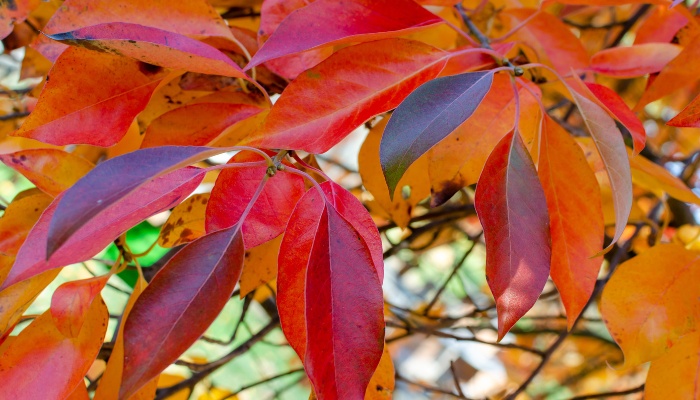
The black gum blooms with small inconspicuous flowers that mature into blue berries in the summer.
In the spring and summer, its leaves are a vibrant green that transition to a red, orange, yellow, and bronze display of color in the fall.
- Best for Grow Zones: 4 through 9
- Mature size: 30 to 50 feet tall and 20 to 30 feet wide
- Key advantages: Attracts songbirds, easy to grow, slow growing
- Potential drawbacks: Staining berries, large invasive roots
3. Crabapple
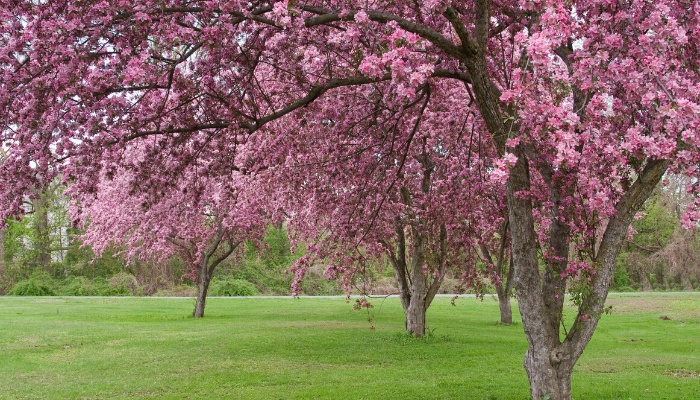
While it doesn’t grow tasty fruit, its wonderful white or pink blossoms display will make up for it! The blossoms mature into small apples in the summer that drop in the late summer and fall.
Crabapples also make universal pollinator trees for all edible apple varieties!
- Best for Grow Zones: 4 through 8
- Mature size: 10 to 20 feet tall and wide
- Key advantages: Beneficial for pollinators and wildlife, universal apple pollinator
- Potential drawbacks: Messy bloom and fruit drop, susceptible to pests and diseases
4. Weeping Willow
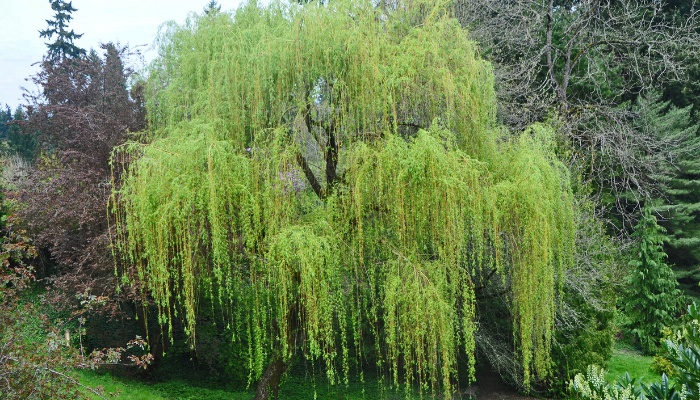
Nothing beats the airy sway of a weeping willow’s branches! Its shade will be bountiful once the tree is mature, thanks to the large canopy that makes a great refuge from the summer sun.
Weeping willows bloom with abundant small yellow flowers in the spring, producing unnoticeable fruit in the summer.
- Best for Grow Zones: 6 through 8
- Mature size: 30 to 50 feet tall and wide
- Key advantages: Easy to grow, prefers moist soil, unique appearance
- Potential drawbacks: Invasive roots destructive to pavement, messy leaf and flower drop, potential diseases.
5. Japanese Maple
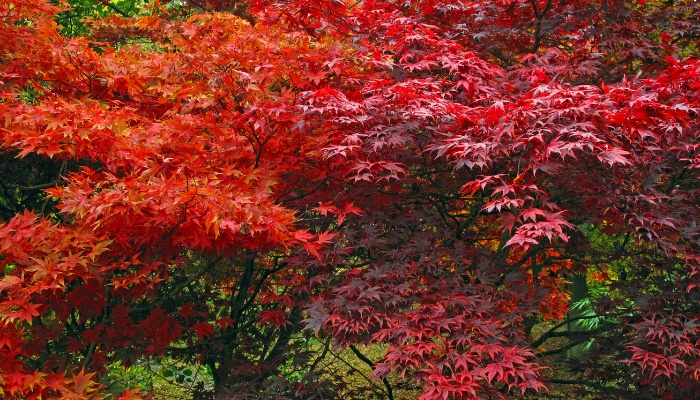
The Japanese maple is good for smaller yards that need some shade. Its delicate leaves will fill in during the spring, and red and green varieties are available.
During the fall, its leaves will transition to yellow and gold before dropping.
- Best for Grow Zones: 5 through 9
- Mature size: 15 to 25 feet tall and 20 feet wide
- Key advantages: Small size, easy to maintain, unique appearance
- Potential drawbacks: Samaras, airy canopy produces light shade
6. Hawthorn

As a shrub or small tree in evergreen and deciduous varieties, hawthorn varieties grow abundant pink or white flowers in the spring.
In the summer, the leaves are dark green and transition to red, orange, and purple shades with red or black berries in the fall. It also grows well as a hedge to create both privacy and shade!
- Best for Grow Zones: 3 through 9
- Mature size: 25 to 30 feet tall and wide
- Key advantages: Drought tolerant, abundant blooms
- Potential drawbacks: Susceptible to many pests and diseases, slightly odorous flowers, staining berries, most varieties have large thorns
7. Hornbeam

This deciduous hardwood tree is in the birch family and is an eastern North American native. Its serrated leaves are a dark, glossy green that turn orange and red in the fall.
Once winter comes, the leaves will brown and remain on the tree until new spring growth begins to form.
- Best for Grow Zones: 3 through 9
- Mature size: 20 to 25 feet tall and 20 to 35 feet wide
- Key advantages: Highly resistant to pests and diseases, strong tree, hardy
- Potential drawbacks: Holds dead leaves until spring, drought susceptible, no significant blooms
8. Dogwood
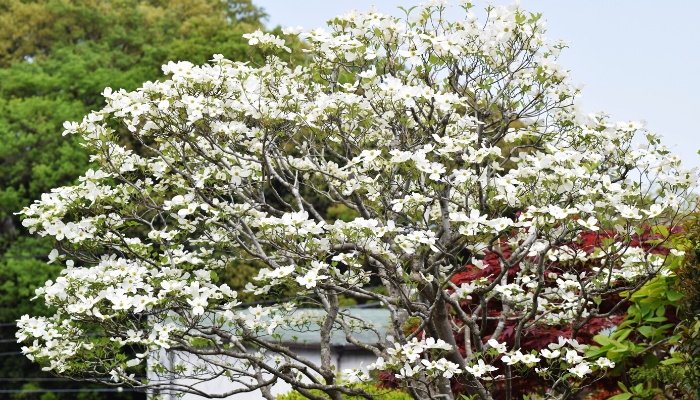
Best known for its white or light pink flowers that bloom in the spring, dogwood varieties grow to a decent size with a dense canopy that produces great shade.
Its flowers are beautiful and last a few weeks into summer. The leaves turn a crimson red in the fall, and its berries fully ripen and fall with the leaves.
- Best for Grow Zones: 5 through 10, requiring light shade in Zones above 7
- Mature size: 15 to 25 feet tall and 10 to 20 feet wide
- Key advantages: Display of spring flowers, easy to grow, medium size
- Potential drawbacks: Messy when flowers petals fall, shorter life span
9. Crape Myrtle
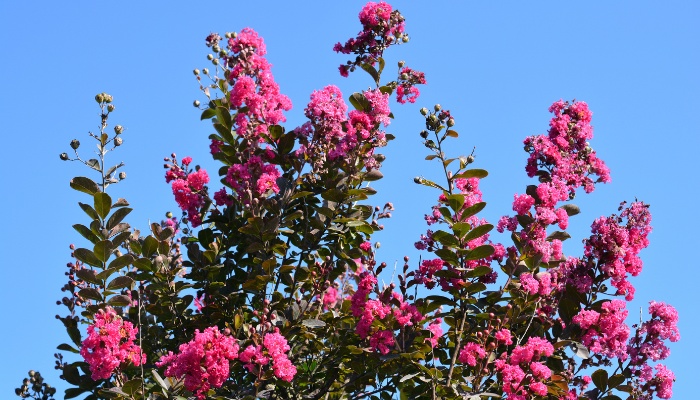
In the spring, summer, and even into the fall, crape myrtles will have a canopy covered in white, pink, or purple flowers. It’s also able to be grown as a small shrub or tree.
Easy to maintain, this tree only looks different in the winter, but from spring through fall it will barely change!
- Best for Grow Zones: 7 through 10
- Mature size: 10 to 20 feet tall
- Key advantages: Unique bark, long blooming period, compact tree
- Potential drawbacks: Grows many suckers, bark can be messy
10. Eastern Redbud
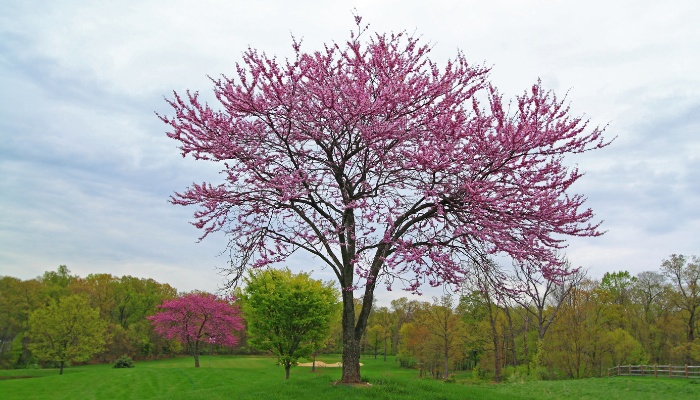
Bright red or pink buds cover the branches in early spring, giving way to heart-shaped (cordate) leaves.
The Eastern redbud displays yellow, orange, and red leaves in the fall and produces bean pods that remain on the tree, eventually falling off through the winter and spring.
- Best for Grow Zones: 4 through 9
- Mature size: 20 to 30 feet tall and wide
- Key advantages: Small and compact tree or shrub, amazing flower bloom
- Potential drawbacks: Messy seed pods, susceptible to pests and diseases
11. Serviceberry
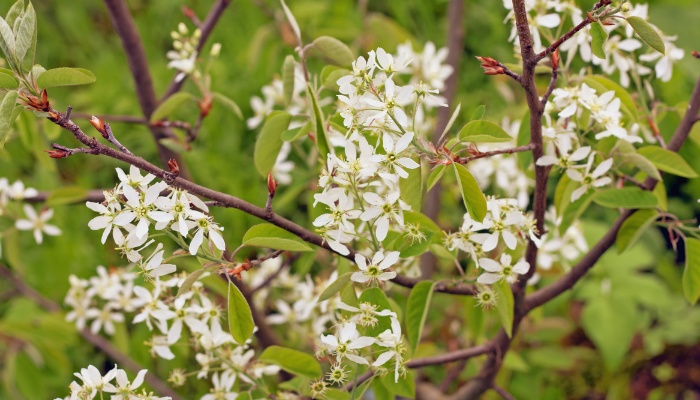
A deciduous variety, the serviceberry can grow as a tree or shrub. Abundant white blossoms will impress in the spring, and many small red and black berries will ripen in the summer.
Once the temperatures begin to drop and fall sets in, its leaves will turn red, orange, and yellow.
- Best for Grow Zones: 4 through 9
- Mature size: 10 to 25 feet tall and 15 to 25 feet wide
- Key advantages: Hardy, easy to care for, impressive spring bloom, small size
- Potential drawbacks: Messy fruit, messy bloom
12. Fringetree

The fringetree’s strong fragrance is its best attribute alongside its abundant white “fringe” textured flowers.
It is a deciduous type of olive tree, and the flowers will bloom before or in unison with the first leaves. In the fall, its fruit ripens in dark-purple drupes.
- Best for Grow Zones: 4 through 9
- Mature size: 15 to 25 feet tall and wide
- Key advantages: Fragrant blooms, slow growing, has medicinal properties
- Potential drawbacks: Attracts wildlife, berries stain the ground, messy petal drop, un-impressive fall leaf colors
13. Honey Locust

A tree with a strong appearance, the honey locust has many small leaves with large thorns that grow from its trunk and branches.
During the spring, its small leaves will begin to grow, filling out with delicate dense foliage in the summer. In the fall, its leaves turn golden-yellow before dropping, exposing its large thorns to add a unique look to your yard in the winter.
- Best for Grow Zones: 3 through 9
- Mature size: 30 to 70 feet tall and 25-50 feet wide
- Key advantages: Unique leaves, easy to grow
- Potential drawbacks: Large thorns grow abundantly, drops seed pods in the winter and spring
14. American Elm
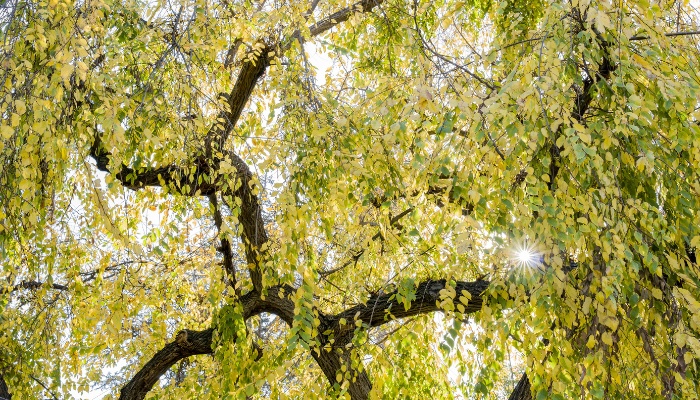
A true classic, the American elm will grow large and strong making an ideal shade tree if you have the space.
Leafing out with a dense canopy of dark-green leaves will drop them in the fall after they turn yellow, light orange, and bronze. In the winter, a mature tree will impress with its great branching structure on full display.
- Best for Grow Zones: 4 through 9
- Mature size: 60 to 80 feet tall and 40 to 60 feet wide
- Key advantages: Easy to grow, hardy, forms a nice canopy shape
- Potential drawbacks: Large size, susceptibility to Dutch Elm disease
15. Linden

With many different lindens to choose from, the most common variety planted in landscapes is the Little Leaf linden.
They have lush dark-green foliage that fills in during the spring while they bloom with white flowers that give an amazing fragrance.
Through summer, they provide great shade with their dense canopy that turns to shades of gold and yellow in the fall.
- Best for Grow Zones: 3 through 8
- Mature size: 50 to 70 feet tall
- Key advantages: Fragrant, easy to grow, has medicinal properties
- Potential drawbacks: Messy flowers and fruit, large invasive roots, susceptibility to pests and diseases
Final Thoughts
Use this list of descriptions, pros, and cons to narrow your search for the best trees for your Grow Zone and backyard.
We’ve only scratched the surface with these 15 great varieties to plant for shade in your backyard, but even more options are out there! Hopefully, this gives you a good place to start when considering what trees to plant.
